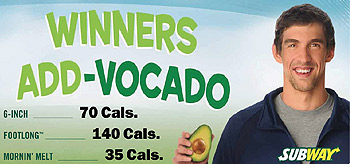Commentary
Why Subway Loves TV
- by Sarah Mahoney , Staff Writer @mahoney_sarah, July 18, 2012
 The fast-food upstart may be digitally driven, but there’s plenty of mainstream media on the menu
The fast-food upstart may be digitally driven, but there’s plenty of mainstream media on the menu
Perhaps we’re fascinated by how many Subway
sandwiches athletes like Michael Phelps and Apolo Ohno get to eat. Or maybe we’re impressed that the chain recently won the stamp of approval from the American Heart Association, the first
fast-food restaurant to do so. Or maybe we’re just suckers for a company that seems happy to spend any of its $358 million ad budget on baby-talking firefighters eating avocadohh. Whatever the
reason, omma caught up with Subway cmo Tony Pace before he left for the London Games, to explain how he’s making his budget decisions these days.
You spend a lot of money on digital
ads. Will that continue, as TV audiences get smaller and become less effective?
Actually, tv is extremely effective for us. We’re very happy with the digital presence we have, and
yes, it’s grown exponentially over the last five years. And there is no doubt that the tv audience is smaller than it used to be. But you can buy media around that. To me, the whole notion of
digital and tv being at odds is wrong. We see them as being incredibly complimentary.
Are you using more or less display in your digital mix?
More. We have our own way of doing
lots of things, and we have different marketing assets so that we can do our own custom creative for the digital world. Without giving away all the secrets of our success, when we’ve done custom
messaging with video and display, we tend to see much higher consumer engagement, which, of course, makes the ad that much more valuable to us. We do testing on all our advertising, and when we
compare it to the qsr industry, we are running slightly more than double the industry norms, in terms of people receiving and retaining our messages.
What other digital programs are
important?
Social media has done very well for us. There is a lot of debate about how effective it is, but it works for us. We think we are an inherently social brand, and our marketing
assets can be readily deployed as conversation starters. And those conversations are relevant to the brand.
For your core customers, how have media habits changed?
They are
consuming media across multiple screens at the same time. So in our category, young males are an important target, and if they are watching a sporting event, they probably also have their phone or
their iPad, too. That behavior allows you to deliver messages on multiple screens at the same time, for, perhaps, greater impact. But there is also the contrarian point of view, and we know there are
some consumers who like going off the grid because they are connected so often. So we really need to find the things they are passionate about, whether it’s tv, a musical act or even a
blogger.
Do you have a favorite digital program?
We work with basketball player Blake Griffin, and last year he was in the Slam Dunk Contest at the All-Star Game. We created a
Blake Griffin “Dunk Fresh” app, where consumers could take a photo of their own head and put it on his body. It debuted on Jimmy Kimmel! Live!, and Kimmel used it. It wasn’t a big
program, but it was timely, and it all came together nicely.
In terms of your personal media snacking habits, what do you like?
I’m a big sports guy, and I play fantasy
sports, so espn.com and cbssports.com. It’s probably old school, but I check on Yahoo finance, too. I’m not a Facebooker. I’m more private than that. And for tv, we’re really
into Person of Interest. We’ve got 9-year-old twins, and believe it or not, it’s the one show we all watch together each week.
As we head into the Olympics, now that
you’ve invested so heavily in Phelps and other athletes in training, how will you measure ROI? When will you know that it’s paid off?
It’s already paid off. Our message
has been about training, and our athletes include Olympians like Phelps and Ohno, but also people like cc Sabathia, Justin Tuck and Robert Griffin iii, as well as athletes everywhere. They are all
training for whatever their athletic endeavor is, and Subway is part of that training. We’ve been tracking the campaign for a long time, and we’ve gotten good feedback.
The
athletic ads are very different from the baby-talkers of the “Get Your Own” campaign. Why have two separate campaigns at the same time?
We always have multiple layers of
marketing going on. We are a big brand, and we appeal to a wide swath of customers. If we had adults do that campaign, it would come across as a little mean-spirited, but because we use kids’
voices, everyone knows it’s playful. The different themes appeal to different audiences, but we think they’re complimentary.



